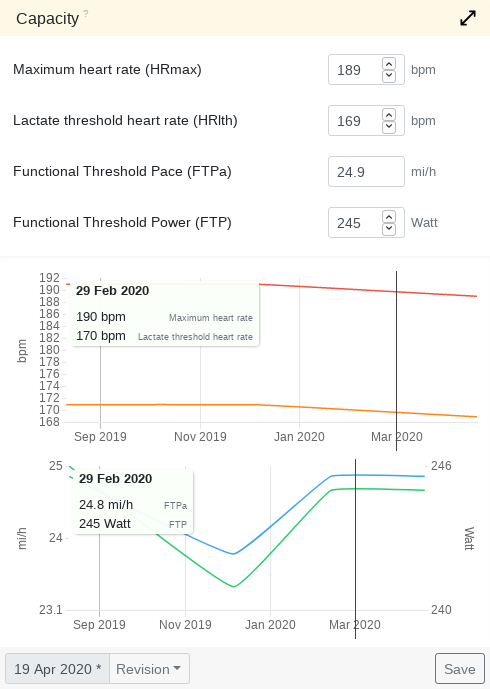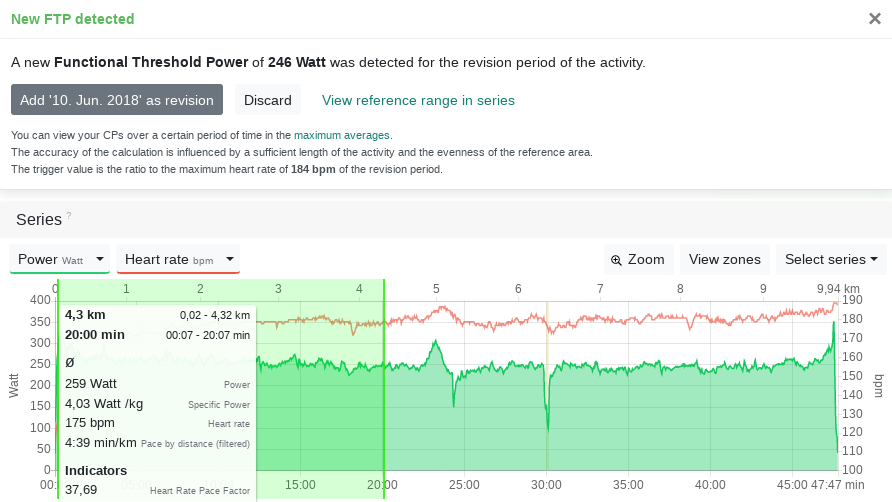Capacity
Capacity
Maximum heart rate, functional power threshold (FTP) and functional power threshold pace (FTPa) are capacity values that significantly influence the categorisation of your training speed, the effort calculation and your zone model and should be re-evaluated from time to time.
Without realistically set capacity values, Tredict will not be able to calculate correct efforts. Of course, you only need to adjust the capacity values according to which you want to train. For example, if you train purely according by heart rate, then it is sufficient if you have set the HRmax correctly.

Capacity values
Maximum heart rate
The maximum heart rate together with the resting pulse forms the heart rate capacity and is the basis for the effort calculation according to heart rate.
Training by heart rate is a widespread and successful method and you can achieve good results with relatively little equipment. Many performance indicators, which are formed from heart rate and speed, are available to you with this method.
Lactate threshold heart rate
The "lactate threshold heart rate" defines the range at which the oxygen utilization of the body is just sufficient to compensate for the oxygen consumption.
Above the lactate threshold, the anaerobic range begins, at which increased lactate is produced by low-oxygen energy production. The lactate threshold value is also often called the aerobic-anaerobic threshold.
Functional Threshold Pace/Tempo (FTPa)
Your FTPa is the basis for the effort calculation by speed.
To train by speed, you need a speedometer, e.g. a GPS watch. Training with the FTPa is universally applicable, as no heart rate belt or power meter is required. On the other hand, training according to FTPa is not as accurate and many advanced indicators that include heart rate or wattage are not available.
Functional Threshold Power (FTP)
Your FTP is the basis for the effort calculation by power (watts).
Training according to wattage is particularly popular in the field of cycling, but has also secured a place for runners thanks to its measurement independent of incline and decline. Training according to wattage generally leads to a better organisation of your strength.
Determining values
The determination of the maximum heart rate, FTPa and FTP is either done by means of a very strenuous competition of suitable length or specially designed test runs, which are available in many variations.
In the records overview of the evaluation you can display these maximum values for a certain period of time.
Automatic determination from intensive training sessions
Tredict can automatically determine the capacity values, such as HRmax, FTP and FTPa, if you have carried out suitable training sessions.
If you carry out training sessions that are sufficiently intensive, the automatic determination of capacity values is activated. The new value for transferring to a new capacity revision is then suggested to you in the detailed view of the executed training. The accuracy of the calculation is influenced by a sufficient length of the activity and the evenness of the reference area.
Read the detailed blog article: Automatic determination of lactate threshold, FTP and FTPa

Calculate FTP from FTPa
If the capacity card displays a magic wand, you can automatically calculate the FTP based on your entered FTPa. It works the same way the other way around.

Correction factor from FTP and FTPa
FTPa and FTP are in direct relation to each other at Tredict, from which we calculate a correction factor.
This way Tredict can keep the relations to older FTPs and revisions when you change your power meter and is still able to measure the correct effort by power. This requires that you always reevaluate the FTP and FTPa simultaneously on a flat and optimal track. Unfortunately, changing to a new power meter is usually associated with a change of value range compared to the old device.